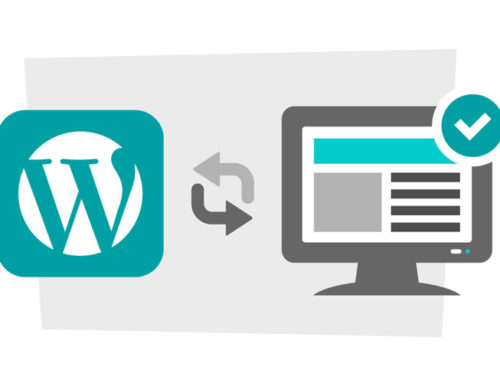Running a website is no simple task — and keeping a website running smoothly is even more challenging. Websites require constant maintenance, especially for e-commerce sites. It’s not uncommon for your site to go down at the most inopportune time; costing you customers, sales, and in some cases, your reputation. If you’re looking for some simple steps to keep your website up and running smoothly, see this article.

1. Update your WordPress software
You should update your WordPress software every time a new version comes out. WordPress releases security updates on a regular basis, and this is especially important if you’re running a website that has a lot of traffic and gets hit with a lot of spam comments. If you don’t keep your WordPress software updated, you’re putting your website at risk.Update your software at least every six months to make sure malware hasn’t been detected in your website.
Try uploading a new version of your site into Google’s Search Console. Before you do anything else, make sure you have backups of any important files.
If you don’t use a CMS, you could consider using a text editor instead. A good text editor, such as Text Editor for Word and Text Editor for Chrome, are usually installed on your websites server. These editors will allow you to do things such as add images, upload new versions of your documents, and edit your site’s code. These are preferable to using a CMS for a couple of reasons:
Coding won’t bog down your website, because the code is already set up, and you don’t have to do any extra work. This is also ideal if you don’t have a designer working for you.
You can use different editors to edit different parts of your website. For example, you could use a text editor to change titles and images for your e-commerce store, or you could use Movable Type to edit product descriptions and content.
If you rely on writing content for your blog, you could just use a simple text editor to draft your posts.
The only thing an editor can’t do for you is add content, but if you’re just starting out with a blog, it makes sense to try and write posts by hand.
If you have a talented developer on your team, you could stop relying on programmers and work on things by hand. They could create your website’s CMS if you don’t have time to work on the CMS yourself.
2. Backup your website
Backing up your website is a crucial step in website management. If your website crashes, and you don’t have a backup, you might lose all of your work and your rankings in the search engines.
To back up your website, you will need a hosting provider, technical knowledge, and a bit of effort. Our tutorial will go over the best hosting options for a variety of purposes, like creating your own website from scratch or backing up your existing website.
If you’re looking for affordable web hosting, you can check out 23 Hosting Features We Love for a variety of reasons, including pricing and advanced features. To find the right hosting service for your needs and budget, check out our roundup of the best web hosts.
A backend database is a method of storing and displaying data. A database is used to store information like customer information, orders, or booking information. It’s essentially a central location for all of your information to live.
However, when setting up a database for your website, you should always choose a hosting provider that can manage your database for you. If you have to do all of the work yourself, you may experience lag time as your website loads. A website’s backend server (also called a “router”) is responsible for serving pages and processing queries, as well as supporting security and data integrity.
The easiest way to manage and update your database is to use a data backup. A database can easily become corrupted if your hosting provider can’t or isn’t provided with a backup.
For most companies, the data backup will better serve your company while working for you.
Some hosting providers can offer an automatic backup and restore service for your database. Other hosting companies provide automatable backup options. However, there are different types of backup.
For your website’s best chance at staying online, it’s important to perform stress testing on your database.
3. Check for malware and viruses
Some malware, or malicious software, is designed to steal your personal information or use your computer to attack other computers. You can avoid this by using antivirus software and running regular scans on your computer. You can also check your computer for viruses by using a free online service, such as Microsoft Security Essentials or Bitdefender.
Just recently, I had to set up a WordPress website for one of my clients, a fitness startup. Although I’ve used WordPress for years without incident, I’m worried this time would be different. After several failed attempts to work around WordPress’ limitations, I finally found a way to get the job done without relying on complicated hacks.
I hope that this tutorial will help you avoid the same frustration. In addition to this guide, I recommend following the steps at the following website to create a WordPress website for your own business:
Before we look at the quick-start guide, I want to clarify that this solution was external to WordPress itself. In other words, someone external to WordPress created the solution. Although they did an excellent job creating the simple to follow guide, we aren’t reliant on these instructions to run your site. They’re a work-around and are not a full feature implementation of how to setup a WordPress website. With that out of the way, here is the official guide to set up a WordPress website rapidly for free and quickly with zero technical knowledge.
The ideal temperature for running a website or blog depends on the person running the site. For the average person, comfortable temperatures are somewhere between 80–95 degrees Fahrenheit. For those with access to the dryer, it’s even better. Dry conditions allow the pages to be refreshed without slowing the loading speed of the site. Figure on 75– 85 degrees under ideal conditions when running a website or blog.
Maintaining a site is more than simply writing content. It’s about ensuring the site runs correctly and maintaining and updating content, using a content management system (CMS), including but not limited to WordPress.
4. Update your plugins and themes
When it comes to your WordPress site, it’s important to make sure you’re always running the latest version of your themes and plugins. A lot of vulnerabilities are being patched by developers on a regular basis and by keeping your themes and plugins up to date, you’re ensuring that your site is as secure as it can be.
Installing WordPress is easy if you’ve never used it before. In fact, I wouldn’t recommend anyone without prior experience try it out for the first time. It can be overwhelming, though, and I urge you to start simple. The first version of WordPress can be overwhelming, especially if you’re coming from another CMS like Shopify, Capterra, or Magento.
If you’ve never tried to install any CMS before, I would suggest getting started with an example site — this will teach you how to install and work with WordPress. It would also help you develop familiarity with the installation processes and themes, lining up the same skill-sets that will be needed later on. There are a couple WordPress hosting platforms — why not start with the fastest and most convenient?
WordPress is very time-consuming to set up. While seven years ago, this would have been a large undertaking in and of itself, today that task can be automated. Automating WordPress is possible with a service like Wix or Squarespace. There are tons of resources online to learn more about how to set this up, so you won’t have to reinvent the wheel.
Instead of a 10+-hour installation, you can expect a much quicker experience with the Wix or Squarespace service. Some themes and plugins require a bit of fiddling around, but you should expect to keep your site running smoothly without too much assistance!
Hitting a major milestone is something most businesses look to do every year. Having a website is just as important as having an impressive product or a successful product launch. Unfortunately, when it comes to running a website, there is so much more to consider than simply designing and shipping an awesome product.
5. Check for broken links on your site
Search engines like Google don’t like broken links, and neither do your readers. Make sure to check for broken links on your site, especially in long blog posts. You can use a tool like Xenu Link Sleuth or a simple Google search to search for errors. If your page is broken due to a broken link, it won’t show in search results.
You also have the option of using robots.txt. This file tells web spiders such as Googlebot how to navigate your site without errors. For this reason, you should always check for robots.txt file inconsistencies whenever you update your site content, especially if you’re not an experienced web developer. If a file isn’t as expected, it might cause problems at your website.
Do you use robots.txt? I would love to see how this file affects your rankings, so feel free to give it a read yourself. Also, I want to call out another content management system (CMS) — WordPress — I mentioned in the intro that WordPress is maintenance-free. However, with the launch of WordPress 2.6, major elements of the CMS became a little more complicated to maintain.
WordPress made their documentation unnecessarily complicated and hard to navigate. This left WordPress users frustrated, and it often took longer to figure out which changes to make. If you’re using WordPress, it’s worth understanding how the system works and how to maintain this website.
Part of this is due to unique compatibility issues between CMS platforms. For this reason, you should also make sure to have some familiarity with the core elements of each of the CMS platforms. This includes understanding how to create new post types, important content technicalities like AMP, or how to link your content.
Seeing as I mentioned at the start that Google and search engines like Google use web spiders to index your site, it’s important to make sure these bots are keeping the site updated. Your users will be skeptical if their favorite page is no longer available.
If all this sounds too much for you then you can always ask us to help with the maintenance of your website. You can find out more by getting in touch: Email us





